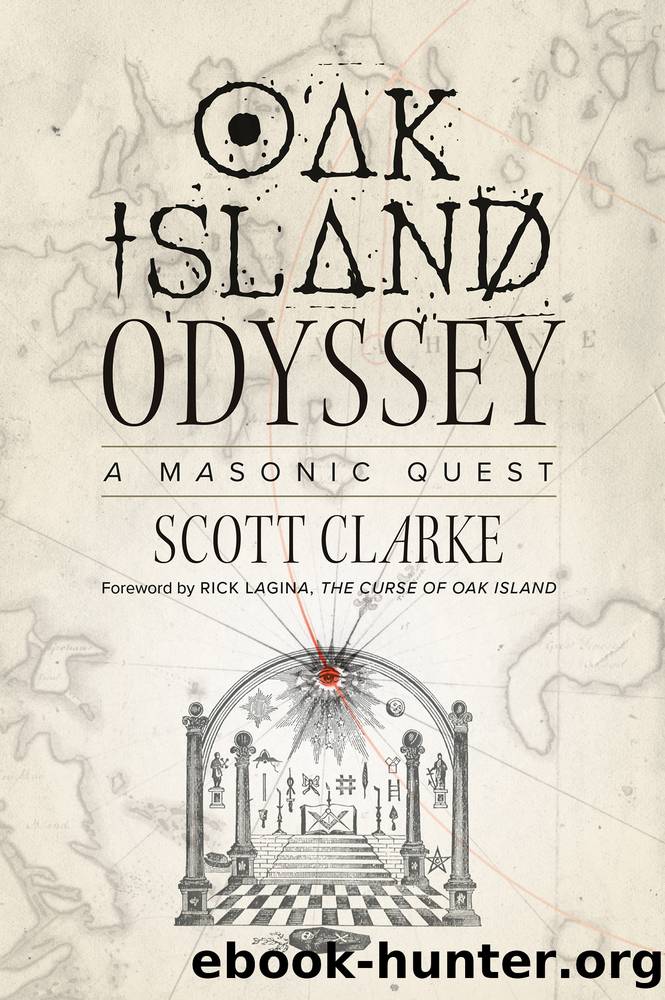Oak Island Odyssey by Scott Clarke

Author:Scott Clarke
Language: eng
Format: epub
ISBN: 9781774711576
Publisher: Nimbus
Published: 2023-03-17T11:35:56+00:00
The Masonic Stone of 1606
Nova Scotia certainly has one of the most Masonic histories of any country, state, or province in the world. The very earliest Masonic connection could be the Stone of 1606 that was found on Granville shore near Annapolis Royal in 1827.
Annapolis Royal, originally called Port Royal, was the second permanent European settlement in all of North America, after Saint Augustine in Florida. Port Royal was established by French colonists under Pierre Dugua, Sieur de Mons in 1605.
The size of the Stone of 1606 is not that different from the alleged 90-foot Stone, which is said to have been discovered deep in the Money Pit on Oak Island. The Stone of 1606 was described in 1829 as being about 2.5 feet (0.8 m) long and 2 feet (0.6 m) wide. According to a paper titled âThe Masonic Stone of Port Royal, 1606â by former Masonic Grand Master of Nova Scotia Reginald V. Harris, weâre also told that âon the upper part are engraved the square and compasses of the Free Mason, and in the center, in large and deep Arabic figures the date 1606.â
The man who discovered the stone, celebrated chemist and geologist Dr. Charles T. Jackson, also records that âit bore the Masonic emblems, square and compass.â
The stone was originally given to Nova Scotian judge and Freemason Thomas Haliburton for safekeeping. In 1856 Haliburton gave the stone to his son Robert Grant Haliburton, and in 1868, it was loaned to Sandford Fleming, the founder of the Royal Canadian Institute for Science in Toronto. It was put on display in the museum of the institute. In 1876 construction began on a new building to house the Royal Canadian Institute at the corner of Richmond Street and Berti Street in downtown Toronto. The address eventually became 58 Richmond Street East.
As the construction was progressing, Dr. Charles Scadding gave instructions to the workers to build the Stone of 1606 into the wall of one of the principal rooms, with the inscription exposed. Unfortunately, one of the workers covered it with mortar and the location could not be rediscovered. Sandford Fleming was devastated and offered a $1,000 reward if the stone could be found. Mortar was uncovered in various locations, but with no success.
Just two years later, the future Sir Sandford Fleming was in this building when he developed and outlined his proposal for standard time and time zones. When standard time was eventually adopted around the world as a universal system, a plaque was added to the corner of the building, marking the site as the birthplace of standard time.
When the building was sold in 1905 to the Sons of England Benevolent Society, it was agreed that, if the stone should ever be found, they would contact the Royal Canadian Institute. In his 1950 paper, Reginald V. Harris states that this âpriceless stoneâ should never have left Nova Scotia, and if the building should ever be taken down, the Grand Lodge of Nova Scotia should see to it that the stone is returned to Nova Scotia.
Download
This site does not store any files on its server. We only index and link to content provided by other sites. Please contact the content providers to delete copyright contents if any and email us, we'll remove relevant links or contents immediately.
| Baha'i | Cults |
| Demonology & Satanism | Eckankar |
| Egyptian Book of the Dead | Freemasonry |
| Messianic Judaism | Mysticism |
| Scientology | Theism |
| Tribal & Ethnic | Unitarian Universalism |
The Four Agreements by Don Miguel Ruiz(5534)
Breaking Free by Rachel Jeffs(3631)
The Hatha Yoga Pradipika (Translated) by Svatmarama(2501)
120 Days of Sodom by Marquis de Sade(2447)
Member of the Family by Dianne Lake(2037)
The Tao of Physics by Fritjof Capra(1861)
The Psychedelic Gospels: The Secret History of Hallucinogens in Christianity by Jerry B. Brown(1830)
The Road to Jonestown by Jeff Guinn(1745)
Uriel's Machine by Christopher Knight(1627)
Going Clear by Lawrence Wright(1578)
Going Clear: Scientology, Hollywood, and the Prison of Belief by Lawrence Wright(1576)
The Grand Grimoire: The Red Dragon by Author Unknown(1420)
The Gnostic Gospel of St. Thomas by Tau Malachi(1415)
Key to the Sacred Pattern: The Untold Story of Rennes-le-Chateau by Henry Lincoln(1353)
The Malloreon: Book 02 - King of the Murgos by David Eddings(1311)
Waco by David Thibodeau & Leon Whiteson & Aviva Layton(1298)
The New World Order Book by Nick Redfern(1260)
The Secret of the Temple by John Michael Greer(1223)
The Initiatory Path in Fairy Tales by Bernard Roger(1180)
